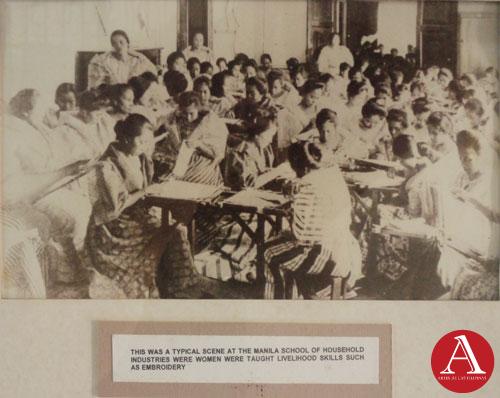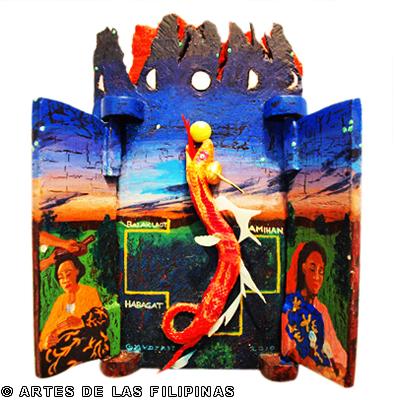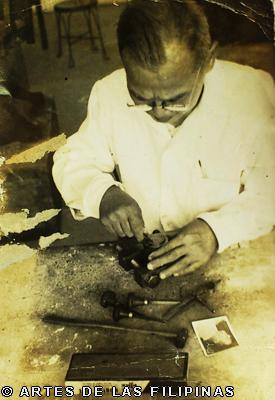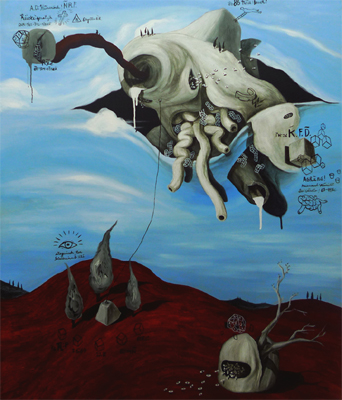
IAN QUIRANTE: A POSTMODERN ARTIST
by: Christiane de la Paz
July 2009–In Philippine contemporary art, very few young artists have been the subject of much interest than Ian Quirante, a progressive young artist of his generation, who employs surrealism and automatic painting in his works. Quirante’s treatment of space was not crowded; his compositions encompass the entire picture surface equally in all places and his use of strongly graphic and biomorphic shapes, phantasmagoric and cartoon-like figures all reveal his psychological ideas and personal visions. In this July 2009 interview, Ian Quirante shares his growing up years in Cagayan de Oro, his college years at the University of the Philippines, shifting from one course to another, the early phase of his career as an artist as well as his personal hobbies and interests.
Graduating from the University of the Philippines in 2005, what was your life like during this period?
It was very frustrating because art is not very much appreciated at that time when I was still based in Cagayan de Oro. I had part time jobs in offices and schools and music tutorials and I worked with friends in a production gigs for musicians there.
Was Fine Arts your first course in college or did you transfer from another course?
I shifted from course to course: Biology, Development Communication, Economics to International Studies. I also took eighteen units of education courses.
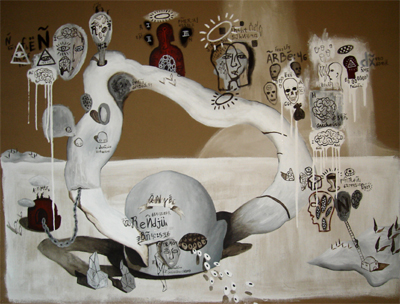
Why did you shift from one course to another?
Back in Cagayan de Oro, the course I chose wasn’t for me. At that time, nothing ever worked out for me.
How was your college life in UP?
UP was like a second home.
Where do you hang out in the campus?
Galleries or at the FA library. I was very focused on my work and I did a lot of research.
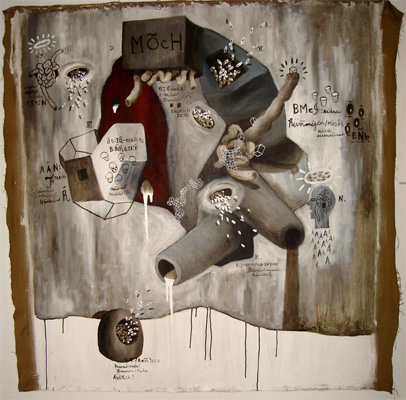
Who are your contemporaries?
Winner Jumalon, Lyle Buencamino, Hanna Pettyjohn, Jaco Payawal and Renan Ortiz.
During your time, who would you consider the professor who influenced you the most?
There are four of them: Leo Abaya, Dodo Defeo, Nestor Vinluan and Rey Concepcion.
Do you think anyone can pursue a career in painting without a formal education?
Everyone is doing that right now. There are a lot of beginner-artists who are only hobbyists. They just took a two month art workshop and after that they would already have their one man show. They even call themselves artists. I think, they have a lot to learn, they need to study and do a lot of research. Knowledge is the weapon in art. It’s like you can’t just be a martial artist just because you watched and memorized all of Bruce Lee’s moves.
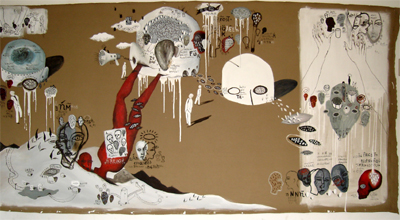
When do you think is the time for someone to be called an artist?
It’s hard to tell but maybe when he’s mature enough from what he has learned. There’s always a very thin line between Art and not Art.
What were you painting back in college?
Explosive colors and maximized space. My canvas was filled up.
These compositions you were doing; was that the direction you were heading or was it a case of “I am submitting this as a plate?”
Partly plate because they were mostly a bit like problem solving. That stage was like my exploration stage.

Whose works influenced you during your student years?
I was influenced by Western artists. Growing up, there weren’t that much books on art by Filipino artists. By reading, I became influenced by Salvador Dali, Rene Magritte, Francesco Clemente, Jean Basquiat, Joseph Beuys, Giotto and the classical masters.
Which Filipino artist did you encounter first?
Napoleon Abueva.
Which among our National Artists do you think is relevant in your generation?
Actually I don’t really know much of our National Artists and I was never really interested in their works because they’ve done it already, so I really couldn’t say much. I am more interested on the new and younger ones because of their new ideas and groundbreaking and provoking concepts.
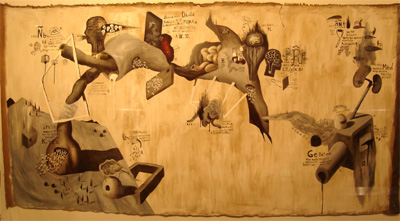
Did you apply for any job after school or did you approach a gallery right away to carry your works?
Boston Gallery took me in for a solo show when I was still in my third year in UP. Then there was the Drawing Room and then Finale finally offered me exclusivity. As of now, I am teaching freehand drawing in St. Benilde, La Salle.
Have you always wanted to become an instructor? How did this offer come about?
My Mom was a teacher. I kind of got it from her and I like to share my ideas with the younger generation.
Back in your beginning days as an artist, was it really that difficult to begin with?
Yes (smiles) because I was always scraping for resources.
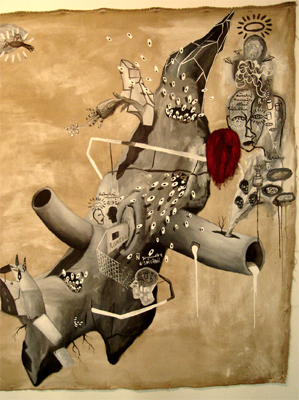
Do you remember the first painting that you sold? How much did you sell the work?
There were two from the Metrobank Student Art Competition. I sold them for Php 8,000 each.
At this time, how are you pricing your work? Do you utilize the per square inch rule or by the months and materials you spent in completing your work?
It goes down with the materials and the time it takes to finish.
What was the first gallery that carried your work?
Boston Gallery.
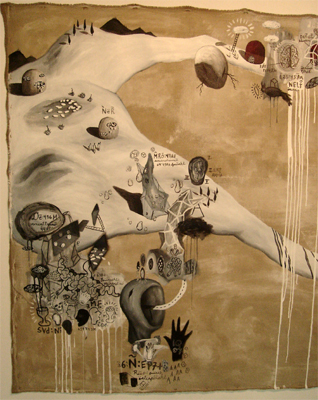
Did Boston invite you to exhibit or was it a case of “I want to exhibit in Boston?”
Boston was my top choice. I talked with Riel Hilario who was the curator at that time and he showed it to Manong Cuanang and they gave me a schedule after that.
Could you tell me some details of your first exhibit? What was your concept for this exhibit and was it a sold out?
My first exhibit went very well. It was the start of my career as an artist. I was focused on the line between drawing and painting. My works all looked like drawing because lines were very dominant on the artworks but the materials were water-based black pencils and acrylics. Nope, it wasn’t a sold out show.
Do you agree that the first exhibit of a painter could make or break one’s career? Did this apply to you?
Sort of. It wasn’t like I got real famous or anything but it gave a solid ground for a start.
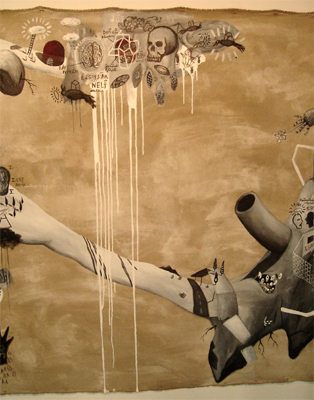
Let’s say, none of your paintings in your first exhibit was bought, will this stop you from painting and perhaps drive you to apply for another job?
No but I might do some teaching in an art class but I’ll still paint.
Are you a member of any artist group?
No. I don’t believe in being in a group. I work alone but I do have a lot of good artist friends.
Why do you not want to belong to an artist group? What do you think are the positive and negative results of being one?
It’s hard to stand out when you’re in a group. Sometimes, there is the tendency to influence each other and your works also tend to look the same. This usually happens especially when one is starting out. I don’t want that to happen to me. Like I said, I like to do my own research.
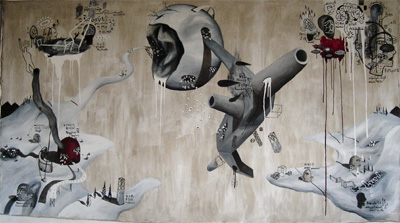
Have you ever won any important awards?
The Philip Morris Top 50 and 30.
Do you think awards help in making the painter become commercially recognized?
Not really but a bit. A lot of artists can become successful even without awards. They just have to come up with good concepts and great artworks. Awards are just props if you ask me and they don’t really impress me.
Does this help in the value place in the succeeding works after winning an award?
Sometimes but I never really believed in awards. There are judges there that are very conservative and some are too old and are very outdated with what’s presently going on in the art world.
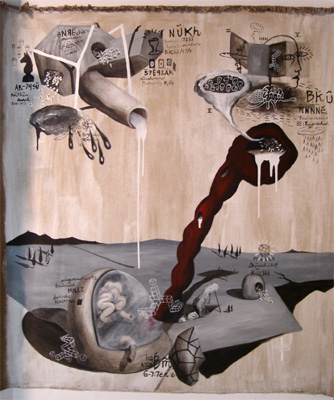
How do you think should judging of competitions be done? Let’s say there are seven judges required to assess all entries, who do you think have better judgments?
I really can’t say but maybe a mix of the old and young artists.
Do you think a painter can become commercially successful without receiving any award?
At this time and age, it’s possible. With hard work, focus and determination, yes.
Is there any award that you wished you have won?
Not that I am aware of. I just want to be a very respected artist, that’s all.
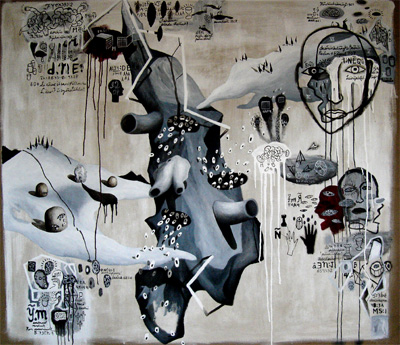
What is your view on the National Artist Award?
It’s ok.
I have noticed that most of your works are Miro and Basquiat-inspired? How did this style come about?
I did a lot of doodling and drawing on walls when I was still a kid and when I saw Basquiat’s works, it really got me hooked.
Has anyone came up to you and told you that your style is “easy?”
Someone once asked me that and then I explained the concept and process of my work and then he told me, “Hirap pala.” (Your style of painting is difficult.)
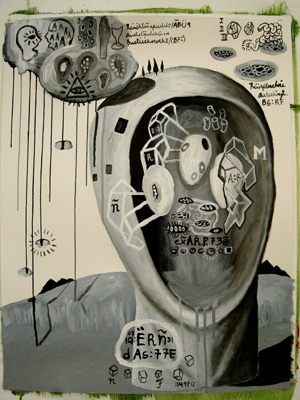
You accomplish large-scale works, is your studio big enough to accommodate your works?
No. I need a warehouse.
Could you tell me about your working method? Do you paint canvases simultaneously or one at a time?
Spontaneous, unplanned and no studies.
Where do you usually shop for your art materials?
National Bookstore and Deovir.
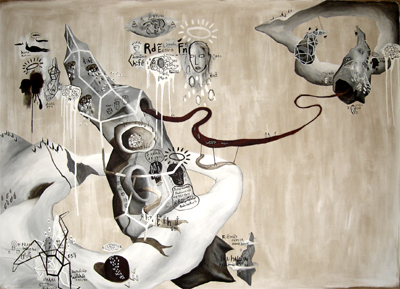
Where do you get ideas for the titles of your works?
English literature.
You sign IQ in your works, is this just your initials or do you want your viewers to be “smart enough” to understand your works?
I got it from my mother. She used to sign using those initials.
I noticed that artists of your generation present an “artist’s statement” for most of the works that are exhibited and sold in galleries. Are you the type of artist to explain your works to your viewers?
Not anymore but the last time I wrote an artist statement it was all jibberish just like the texts I put on my paintings. Surprisingly, one of the clients wanted to have it which I find quite cool.
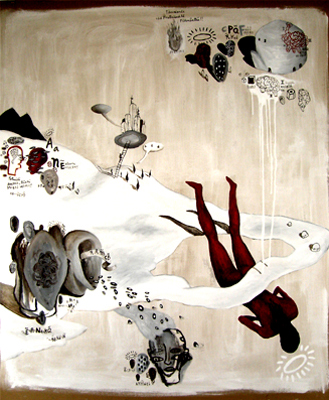
Why are you not into the idea of having your paintings framed? Is this deliberate?
My concept is on spontaneity. It’s like drawing when you pick up a paper and pencil and make doodles; the same goes with unstretched canvas; grab one and paint.
Let’s say there are a hundred of contemporary artists in the art scene today, do you think your style will stand out?
I think so. I’m doing well so far (smiles).
Could you enumerate some local painters who have an influence on your art?
Right now, Tatong Recheta Torres and Costantino Zicarelli. Good people.
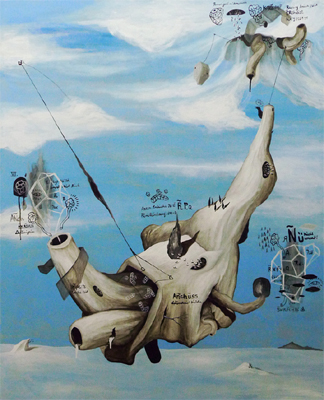
What about foreign influences? Who have fascinated your imagination?
Dali, Magritte, Miro, Clemente, Cucchi, Basquiat, Giotto, Schnabel to name a few.
Has your parents or siblings seen your works? What do they have to say about your works?
Yes, well even if they don’t really understand my works, they have been very supportive. I can’t thank them enough for that.
What has been the best thing written about you?
When someone wrote about what my work was all about, how I came up with the concept and the execution and that my work is about spontaneity.
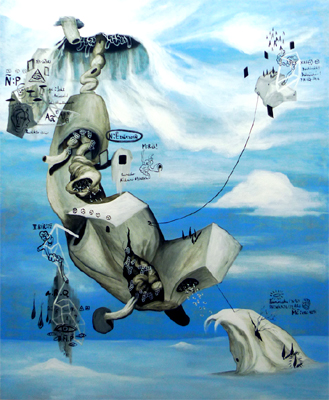
And what has been the worst?
A writer in the Philippine Daily Inquirer wrote about the artists who influence my works. He didn’t even bother to interview me. He made up all the things he had written in his article.
What can you say is your clear talent in painting?
No sketching, no studies, no mistakes. I just paint.
Could you say at this time that you already have a group of collectors supporting your works?
Yes.
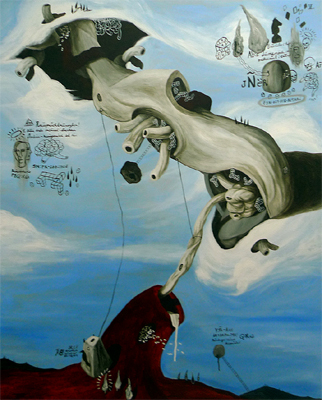
Do you have any idea what type of collector who buys your works?
As I was informed, majority of the collectors who buy my paintings are not from the Philippines.
Have you had plenty of commissioned works in the past? Does commissioned works excite you?
Yes but when collectors get real pushy and they’d tell me, “I want this color or I want it to look like this and that”. I tend to hate that part. They should just hire a portrait artist in the mall.
Have you had any bad experiences with a collector?
Yes.
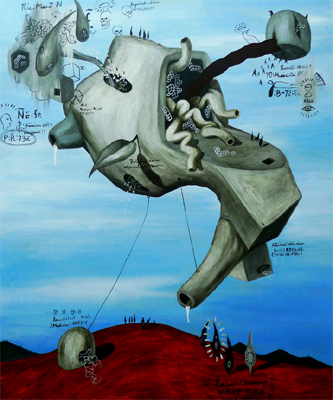
Is there a collector you wish who would collect your works?
There are some (smiles).
What do you think of the works of the young artists being auctioned? Is it something that you welcome in your early career?
They should give it time. They should not rush.
On a personal level, could you tell me about you?
I came from a family of musicians. As far as I can remember, I have been drawing since the age of three. I graduated with two college degrees: International Studies in Ateneo de Cagayan de Oro and Fine Arts in UP Diliman. I became a full-time gallery artist in 2003 and I have been painting ever since.
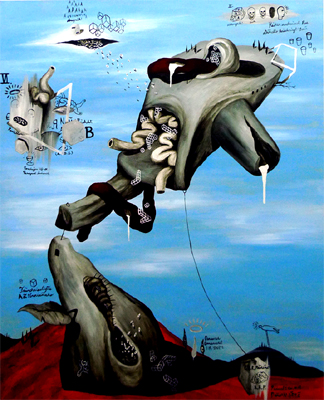
What else occupy you aside from painting?
I teach basic freehand drawing at La Salle St. Benilde and I’m the front man of the electro-industrial rock band, SWITCH. We recently released our album, Visceral under an Indie label sonic shape records.





